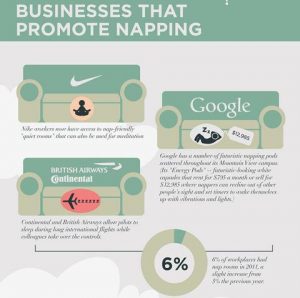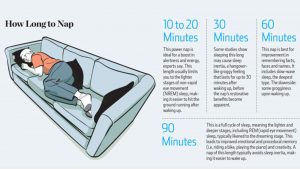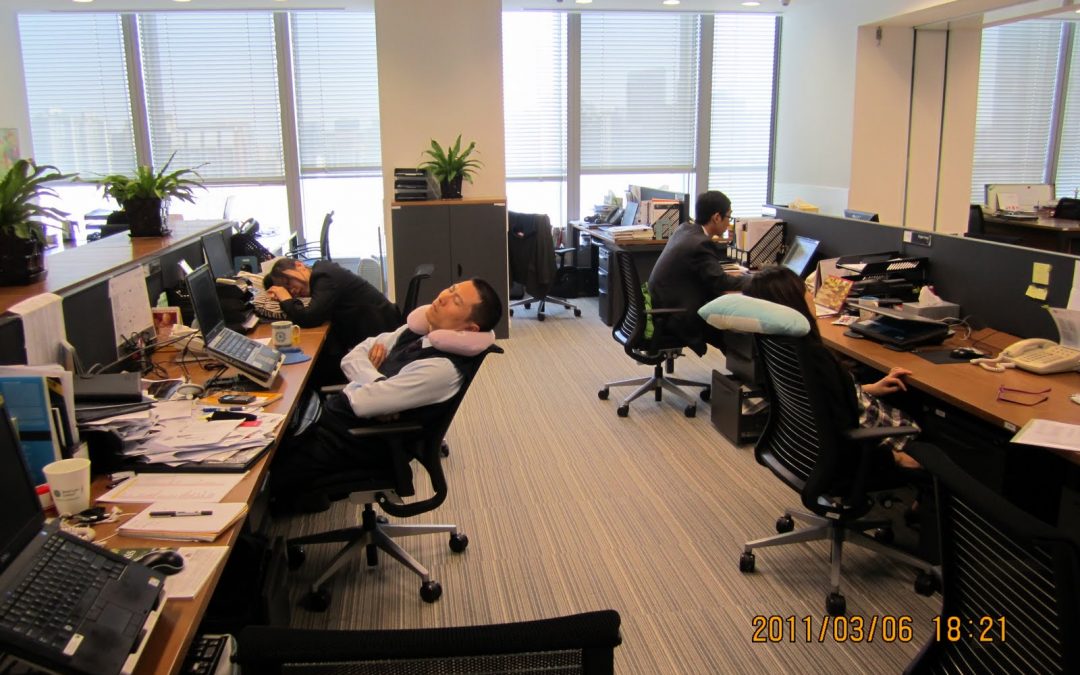People who have a nap during the day are often viewed to be lazy, less productive, and possessing inadequate sleep. Not so, according to research. Napping can make you more productive and healthier.
We’ve often heard and read stories of the habits of a Winston Churchill or John F. Kennedy catching their afternoon nap as a lifetime habit. New research from the University of California, Berkeley, shows that an hour’s nap can dramatically boost and restore your brain power. Indeed, the findings suggest that a “biphasic” sleep schedule (sleep at night, nap in afternoon) not only refreshes the mind, but can make you smarter.
Sleep Deprivation and Napping
One of the best arguments for napping is the damage that can be caused by sleep deprivation.A recent study in the journal Nature Medicine points out that sleep deprivation has been linked to a whole range of health problems, including obesity, diabetes, stroke, heart attack and even death.Death may be caused by long-term sleep deprivation leading to various health problems.But it can also be caused in an instant by a driver falling asleep at the wheel or an over-tired surgeon making the wrong incision.The study, by neuroscientists and psychiatrists at American, French and Israeli universities, examined how the brain behaves when it is deprived of sleep.It found that losing one night’s sleep stops our brain working properly. Neurons fire more slowly than usual, meaning our brain takes longer to translate visual input into conscious thought.
During the course of the day, the more hours we spend awake, the more sluggish our minds become, according to the same research. The research supports the data that college students or workers who pull an all-nighter to cram knowledge, actually decrease the ability to learn by up to 40%.
These findings reinforce the researchers’ hypothesis that sleep is needed to clear the brain’s short term memory storage and make room for new information. Fact-based memories are temporally stored in the hippocampus before being sent to the brain’s prefrontal cortex, which may have more storage space. A memory-refreshing process occurs when nappers are engaged in a specific stage of sleep, known as Stage 2 non-REM sleep, which takes place between deep sleep (non-REM) and the dream state known as Rapid Eye Movement (REM). Previously ,the purpose of this stage was unclear, but the new results offer evidence as to why humans spend at least half their sleeping hours in Stage 2, non-REM sleep.
A team of researchers at Saarland University headed by Professor Axel Mecklinger have shown that a short nap lasting about an hour can significantly improve memory performance. The results of the study have been published in the journal Neurobiology of Learning and Memory.
Sara Studte, a graduate biologist specializing in neuropsychology, working with her PhD supervisor Axel Mecklinger and co-researcher Emma Bridger, examined how power naps influenced memory performance. The results are clear: ‘Even a short sleep lasting 45 to 60 minutes produces a five-fold improvement in information retrieval from memory,’ explains Axel Mecklinger.
The research teams drew a clear conclusion from its study: ‘A short nap at the office or in school is enough to significantly improve learning success. Wherever people are in a learning environment, we should think seriously about the positive effects of sleep,’ says Axel Mecklinger. Enhancing information recall through sleeping doesn’t require us to stuff bulky tomes under our pillow. A concentrated period of learning followed by a short relaxing sleep is all that’s needed.

This is backed up by a study of Chinese people aged 65 and older, which found post-lunch napping improved their cognitive abilities.
University of California psychology professor Dr Sara Mednick, author of Take a Nap! Change your Life, goes even further in listing the benefits of napping. She claims it “increases alertness, boosts creativity, reduces stress, improves perception, stamina, motor skills, and accuracy, enhances your sex life, helps you make better decisions, keeps you looking younger, aids in weight loss, reduces the risk of heart attack, elevates your mood, and strengthens memory”.
But for healthy adults who do get a reasonable amount of nighttime sleep, is there any benefit to a midday nap? Signs point to yes, says Kimberly A. Cote, PhD, a psychology professor at Brock University in Ontario. While little work has been done to look at the long-term effects of habitual napping, studies point to a variety of immediate benefits following an afternoon nap. “If you’re talking about a healthy adult population, I think just about anyone could benefit from a nap,” she says.
Even in well-rested people, naps can improve performance in areas such as reaction time, logical reasoning and symbol recognition, as Cote described in a 2009 review (Journal of Sleep Research, 2009). They can also be good for one’s mood.
A study by University of Michigan doctoral student Jennifer Goldschmied and colleagues found that after waking from a 60-minute midday nap, people were less impulsive and had greater tolerance for frustration than people who watched an hourlong nature documentary instead of sleeping (Personality and Individual Differences, 2015). Researchers are only just starting to understand how naps might affect emotion regulation, Goldschmied adds. But the benefits of napping for memory and learning are well described. “Even a brief bit of sleep helps reinforce learned material,” she says.
Further, Mednick and colleagues found people performed just as well on the test after a 60- to 90-minute nap as they did after a full night of slumber (Nature Neuroscience, 2003).
“What’s amazing is that in a 90-minute nap, you can get the same [learning] benefits as an eight-hour sleep period,” Mednick says. “And actually, the nap is having an additive benefit on top of a good night of sleep.”
In another experiment, Mednick found that an afternoon nap was about equal to a dose of caffeine for improving perceptual learning. But in other ways, a midday doze might trump your afternoon latte. She found people who napped performed better on a verbal word-recall task an hour after waking compared with people who took caffeine or a placebo (Behavioural Brain Research, 2008). While caffeine enhances alertness and attention, naps boost those abilities in addition to enhancing some forms of memory consolidation, Mednick notes.
Other research builds the case that the hippocampus benefits from a nap. Matthew Walker, PhD, a professor of psychology at the University of California, Berkeley, and colleagues recruited volunteers to tax their associative memories by learning a long list of name-face pairings. Half the participants then took 90-minute midday naps. That evening, the participants were given a new round of learning exercises with novel pairings. Those who hadn’t napped didn’t perform as well on the evening test as they had in the morning. But the nappers did better on the later test, suggesting the sleep had boosted their capacity for learning (Current Biology, 2011).

With age come changes in the structure and quality of our sleep. After about age 60, we have less deep (slow-wave) sleep and more rapid sleep cycles, we awaken more often, and we sleep an average of two hours less at night than we did as young adults. It was once thought that older people didn’t need as much sleep as younger ones, but experts now agree that’s not the case. Regardless of age, we typically need seven-and-a-half to eight hours of sleep to function at our best. So if you’re not getting enough sleep at night, what about daytime naps? Or does napping disrupt the sleep cycle, ultimately yielding less sleep and more daytime drowsiness?
These questions were addressed in a recent study by researchers at the Weill Cornell Medical College in White Plains, N.Y., and published in the Journal of the AmericanGeriatrics Society (February 2011). The authors concluded that napping not only increases older individuals’ total sleep time—without producing daytime drowsiness—but also provides measurable cognitive benefits.
Napping rates are greater in countries like Greece, Brazil and Mexico that have a culture of siesta, which incorporate “quiet time” in the early afternoon for people to go home for a nap. In such countries, up to 72 percent of people will nap as often as four times per week.
What do staff at NASA, Google and Samsung have in common? They can all go for a nap at work in a specially designed sleep pod. Engineers, programmers and astronauts can lie down in the pod for 20 minutes at a time. With the outside world shut out by a large visor, the pod plays soothing sleep music before gently waking its occupant up with natural light patterns.

The company behind the pods, New York-based MetroNaps, also supplies law firms, management consultancies and airlines. Any business, in fact, that is “interested in attracting and retaining good-quality employees”, MetroNaps chief executive Christopher Lindholst told the Financial Times in a recent interview.
Despite all the research evidence, we should expect to see progressive CEOs institute policies encouraging employee napping. But they don’t according to the New York Times. Instead many employees surreptitiously seek out restrooms or cars or storerooms to take their naps.
And a widely adopted innovation championed by many business leaders–the open plan office–makes napping at your desk almost impossible despite the evidence that open plan offices decrease productivity.
When Is the Best Time for a Nap?
Research suggests, a brief, early-to-mid-afternoon nap provides the greatest rejuvenation when compared to naps at any other time of the day.
The Benefits of Napping:
-
Napping Can Boost Your Immune System
Sleep deprivation—particularly repeated, chronic lack of sleep—takes a toll on your neuroendocrine and immune functions by increasing inflammatory molecules known as cytokines, as well as stress hormones like cortisol and norepinephrine. A 2015 studyin the Journal of Clinical Endocrinology & Metabolismtook 11 healthy young men and restricted them to a night of only two hours of sleep. Blood and urine tests measured higher cytokines and levels of norepinephrine in both groups after sleep deprivation. The following day, one group was given two half-hour naps, while the control group did not have any naps. Blood and urine samples of those who napped showed that their cytokines and norepinephrine levels had returned to normal, as though they had never lost a night of sleep.
2. A Nap Can Improve Night Alertness
For people who work at night, or through the night, several studies have shown that naps from between 30 minutes and four hours long that are taken in advance of the shift—what’s known as a “prophylactic nap”—improve performance and alertness. These naps can also improve nighttime driving alertness on the way home from the shift. However, most of these studies also include the administration of caffeine, which likely contributed. Yet a 1995 study in Sleep, which compared naps and caffeine, found that “naps, in general, provided longer and less graded changes in performance, mood and alertness than did caffeine, which displayed peak effectiveness and loss of effect within about six hours.”
3.Naps Plus Caffeine are a One-Two Punch Against Sleepiness.
Surgeons must often perform continuous surgery for hours longer than the average person would ever have to persist at a task. A 1994 study in the journal Ergonomics found that naps were indeed effective at keeping surgeons who had to remain awake for 24 hours alert, but only when caffeine was administered, too. Neither naps or caffeine alone were sufficient.
4. To Improve Daytime Alertness, Take Frequent Naps.
Daytime napping also appears to improve mental alertness and performance, according to a number of laboratory studies. However, researchers found that shorter naps were more effective than longer ones. The most effective time of them all was 10 minutes, which produced the best outcomes in all sleep measures including “subjective sleepiness, fatigue, vigor, and cognitive performance.” A 30-minute nap could produce the same effects but brought about “a period of impaired alertness.”
5. Naps Help You Learn New Skills.
If you want to get better at learning a new skill, you might want to take more frequent naps. A 2006 study in Biological Physiology broke participants into two groups: those who napped frequently and those who napped sporadically. Each group was given a nap before a reading task. Habitual nappers—people who reported napping frequently—did better on the reading and retention task. Researchers determined that the brains of habitual nappers consolidated motor learning better, which is part of the process of learning a new skill.
6. Napping Improves Your Physical Stamina.
It turns out that napping is not only just good for mental processes, but has a positive impact on physical stamina and performance as well. A 2007 study in the Journal of Sports Sciences put 10 healthy men through a series of sprints before and after a 30-minute, post-lunch nap. Sprint times improved after the naps, suggesting to the researchers that a post-lunch nap “improves alertness and aspects of mental and physical performance following partial sleep loss.” They suggest that napping may be an important part of the regimens of athletes who are undergoing restricted sleep during training or competition.
7. Napping Improves Your Memory.
One of the many functions of regular nighttime sleep is to consolidate memory. A 2010 study in Neurobiology of Learning and Memory set out to see whether daytime naps also improve memory processes, particularly associative memory (the ability to make connections between unrelated objects). Thirty-one healthy participants were given a learning task at 12 p.m. to memorize two sets of face-object photograph pairs. The objects in each pair occurred in both sets but were paired with different faces. Participants were broken into two groups: those who had a 90-minute daytime nap or those who did not. At 4:30 p.m., participants who napped showed notably better retention of associative memory.
8. A 90 Minute Nap is as Good As a Full night’s Sleep for Perceptual Learning
Previous research demonstrated that people perform better on a visual texture-distinguishing task after a night of sleep than they do immediately after learning it. A 2003 study in Nature Neuroscience found that people performed just as well on the test after a 60- to 90-minute nap as they did after a full night of slumber.”What’s amazing is that in a 90-minute nap, you can get the same [learning] benefits as an eight-hour sleep period,” lead author Sarah Mednick said in an interview with the American Psychological Association. “The nap is having an additive benefit on top of a good night of sleep.”
-
Short Naps Help You Maintain Your Alertness to Stimuli.
A 2014 study in the journal Nature Neuroscienceshowed that people who took a 30-minute midday nap paused this decline in attention, and those who snoozed for 60 minutesactually reversed some of that day’s deterioration.
-
Napping Can Help People Suffering from Depression
Different studies have shown other positive impacts of catnaps. For people with depression, napping seems to help refocus attention away from bad experiences.
-
Napping Can Help You Deal with Physical Pain.
One small study on the general population showed a reduction in pain sensitivity after a midday doze.
-
Napping Can Improve “Working Memory.”
A NASA study of astronauts’ sleep patterns found that the main cognitive function improved by napping was “working memory”. This is the ability to multitask – focusing attention on one task while holding other tasks in memory.
-
Napping Can Reduce the Risk of Heart Disease.
Other studies have shown napping reduces the risk of heart disease.
-
Napping Can Improve Motor Learning.
Another research group found that motor learning, which is where brain pathways change in response to learning a new skill, was significantly greater following a brief afternoon nap for regular nappers when compared to non-nappers.
What is the Optimum Nap Time?
While the participants of the Chinese study napped for more than an hour, most research suggests that the best naps end before you enter deep sleep. As this occurs at around half an hour into sleep, anything less than 30 minutes is considered optimal.
This is the reason that air traffic controllers in the US are told to take 26 minute naps, and that the sleep pods occupying the offices of Google and Samsung wake you up after 20 minutes.
Here’s your new naptime mantra: “Keep it brief.” While everyone you know swears by a certain magic number (7 minutes! No, 17 minutes!), the National Sleep Foundation has this to say: “a short nap”—say, 20 minutes—“can help to improve mood, alertness and performance,” without side effects like grogginess.
When you lie down for those 20 minutes of shuteye, even if you’re really tired, it can be hard to actually fall asleep. To help, try to simulate nighttime conditions. Reduce light with a mask, blackout curtains, or—if for some strange reason your office actually invested in one—a workplace nap “pod.”
If you still can’t convince your body it’s time to zonk out, try listening to some music before you go to sleep. One study, published in a 2017 edition of the journal Sleep Medicine, showed that listening to music before napping helped patients sleep for more of the allotted napping time. They were also more alert than non-musical nappers when they woke up.
Feeling really experimental? Try napping after drinking coffee. Several studies have shown that if you caffeinate before as short nap of 15 to 20 minutes, you’ll wake feeling even perkier than usual, because caffeine takes about 20 minutes to kick in. As Vox put it, “coffee naps are better than coffee or naps.”
Whatever you do, don’t try to replace your evening z’s with napping. While it has plenty of benefits, 20 minutes of shuteye in the afternoon is nothing like a good night’s rest.

Copyright: Neither this article or a portion thereof may be reproduced in any print or media format without the express permission of the author.
Read my latest book:Eye of the Storm: How Mindful Leaders Can Transform Chaotic Workplaces, available in paperback and Kindle on Amazon and Barnes & Noble in the U.S., Canada, Europe and Australia and Asia.


